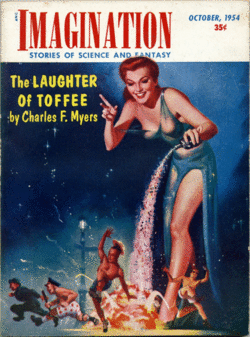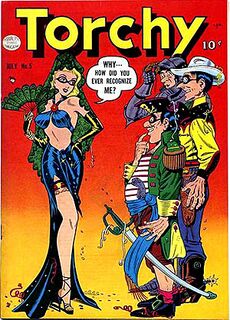Good girl art
From Hey Kids Comics
| Good girl art | |
|---|---|
 Harold W. McCauley illustration for Imagination | |
| This topic covers comics that fall under various genre. | |
| Related articles | |
| Bad girl art |
Good girl art (GGA) is found in drawings or paintings which feature a strong emphasis on attractive women no matter what the subject or situation. GGA was most commonly featured in comic books, pulp magazines and crime fiction. When cited as an art movement, it is usually capitalized as Good Girl Art.
The term describes the work of illustrators skilled at creating sexy female figure art; it is "girl art" which is "good". Popular culture historian Richard A. Lupoff defined it as:
| “ | A cover illustration depicting an attractive young woman, usually in skimpy or form-fitting clothing, and designed for erotic stimulation. The term does not apply to the morality of the "good girl", who is often a gun moll, tough cookie or wicked temptress.[1] | ” |
History[edit | edit source]
The term Good Girl Art (with all initial capitals) was coined in the early 1970s by veteran comic book dealer and The Comic Book Price Guide advisor David T. Alexander, formerly co-owner of the American Comic Book Company. Alexander inserted the term in his company's sale lists to highlight specific panels and covers with sexy women in comic books from Fiction House and other publishers. Shortly after The Comic Book Price Guide was created by Robert Overstreet, the duo of David and his business partner Terry Stroud began to contribute historical, reference and pricing information regarding this particular genre. David currently owns and operates David T. Alexander Collectibles in Tampa, Florida, and continues to sell Good Girl Art comics.
It was during this era that the terms Good Girl Art and Esoteric Comics became widely used by the collecting community. Use of the phrase has since expanded to indicate a style of artwork in which attractive female characters of comic books, cartoons and covers for digest magazines, paperbacks and pulp magazines are rendered in a lush manner and are shown in provocative (and sometimes very improbable) situations and locations, such as outer space. The artwork sometimes involves bondage or damsel-in-distress situations.
A strong influence on the movement was illustrator Rolf Armstrong (1889–1960), labeled the "Father of Good Girl Art" because of his creamy calendar art for Brown & Bigelow and iridescent illustrations for such magazines as American Weekly, College Humor, Life, judge, Photoplay, Pictorial Review and Woman's Home Companion, along with his advertisements for Hires Root Beer, Palmolive, Pepsi, Oneida Silverware and other products.
During the peak period of comic book Good Girl Art, the 1940s to the 1950s, leading artists of the movement included Bill Ward (for his Torchy) and Matt Baker. Arguably the king of Good Girl Art, Baker was one of the few African Americans working as an artist during the Golden Age of Comics. Today, Baker's rendition of Phantom Lady is considered a collectors item, and much of his GGA is sought after. During this period, GGA also found its way into newspaper comic strips. One of the early examples was Russell Stamm's Invisible Scarlet O'Neil, a superheroine who was regularly shown in her lingerie.[2]
Two of the leading creators of GGA for science fiction magazine covers were Earle Bergey (Startling Stories, Thrilling Wonder Stories) and Harold W. McCauley (Imagination, Fantastic Adventures). In the '70's pulp fiction, Hector Garrido drew the GGA book covers of Baroness spy thriller series by Paul Kenyon and The Destroyer men's adventure pulp novels by Warren Murphy and Richard Sapir.
Publications[edit | edit source]
In 1985, Bill Pearson edited and published Good Girls, a collection of artwork by himself, Vince Alascia, Richard Bassford, John Beatty, Stan Drake, Brad W. Foster, Frank Frazetta, Frank Godwin, V. T. Hamlin, David Karbonik, Roy Krenkel, Bob McLeod, Ed Paschke, Victor Perard (author of Anatomy and Drawing and How to Draw), Willy Pogany, Trina Robbins, Kenneth Smith, Wally Wood, Mike Zeck and others.
Since 1990, AC Comics has published 19 issues of his Good Girl Art Quarterly (incorporating several issues of Good Girl Comics), featuring a mix of photos and new comics with reprints of vintage stories. In addition to Baker, Black, Frazetta, Ward and Wood, the artists in this series include Nina Albright, Chris Allen, Nick Alton, Dick Ayers, Frank Bolle, Gill Fox, Brad Gorby, Mark Heike, Chad Hunt, Jack Kamen, Ed Lane, Steve LeBlanc, Bob Lubbers, Billie Marimon, Mark Moore, Ralph Mayo, Pete Morisi, Rudy Palais, Nick Poliwko, Bob Powell, Richard Rome and Maurice Whitman.
See also[edit | edit source]
Notes[edit | edit source]
- ↑ Lupoff, Richard A. The Great American Paperback: An Illustrated Tribute to Legends of the Book. Collectors Press, 2001.
- ↑ "Not Seen but Not Forgotten: The Invisible Scarlet O’Neil," Hogan's Alley, 2010
References[edit | edit source]
- Beaulieu, Dennis. Interview with artist Richard Bassford on Wally Wood and Good Girl Art. CFA-APA 40 (Spring, 1996), publication of the Comic & Fantasy Art Amateur Press Association.
- Jim Burrows: Cheesecake and the Art of the Pin-Up. Illustrated book-length study on origins of cheesecake art to the present.
- Jim Burrows: "Strong Women in Comics." Illustrated survey of Good Girl Art
External links[edit | edit source]
| Wikimedia Commons has media related to Good girl art. |
| |||||||||||||||||||||||||



